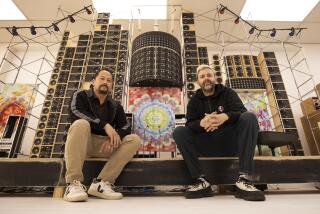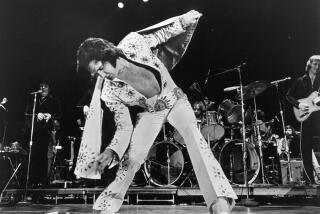GOLDEN-AGE MACHINES ARE MUSIC TO HIS EARS
When Lewis McVay was a youngster growing up in the 1950s, his family often visited a particular Chinese restaurant. Against one wall was a vintage 1940s jukebox, complete with bubble tubes and bright plastic panels that changed colors. Young Lewis wasn’t sure what it was--to him it was just “one fantastic night light”--but he was fascinated, and he would always get his family to request a table near the machine.
He had no idea then that the seeds of an obsession had been planted.
Today, McVay, 32, is a musician, playing his own Christian music. The Costa Mesa resident is also a collector--and lover--of relics of the so-called “golden age” of jukeboxes.
“I come purely from a ‘40s viewpoint,” McVay said of his hobby. “I’m slightly a snob when it comes to ‘40s boxes. To me, they almost don’t exist after, say, 1953.”
McVay picked up his first jukebox in the mid-1970s, when the hobby began gaining popularity. At first he would buy almost anything, restoring machines and reselling them in the hopes of someday owning the box of his dreams--a Wurlitzer 1015.
The colorful Wurlitzer jukeboxes of 1938 to 1948 are the most sought after by collectors. “You didn’t have to put any money in to enjoy them,” McVay says.
Model 1015 was introduced in 1946. With World War II over, America was apparently ready to party, and the 1015 became the most popular jukebox ever. That popularity has not worn off with collectors: a fully restored 1015 can bring $7,500 and more.
Today, McVay has three 1015s, in various stages of restoration, and a 1946 Rock-Ola 1422. At his “semi-leisure,” McVay restores the boxes, a job that can take six months or longer.
McVay described the work as a labor of love. “To me, it’s like saving a Rembrandt,” he said.
The advent of the 45-rpm record and the 100-selection machines in the late 1940s and early 1950s “blew these things out of the water,” McVay said of the golden-age machines. Businesses no longer wanted the fancy Wurlitzers, which offered only 24 78-rpm selections. “Most people thought they were just worthless, and out they went.”
Distributors were stuck with the unwanted machines. Some were sold to private customers for their homes, many made their way into Mexico, and some even ended up in the dump. Much of the collecting thrill comes from finding the jukeboxes in garages, warehouses or wherever they languish.
“They can turn up any place and every place,” McVay said. The classic boxes have become harder to find, however, and the “silver age” boxes of the ‘50s and ‘60s are becoming increasingly popular with collectors. “There are some very nice, affordable jukeboxes out there for the average buyer,” McVay said.
McVay’s real enthusiasm, though, will always be reserved for the 1940s Wurlitzers. “I don’t like all jukeboxes. In fact, I hate some jukeboxes,” he admitted. Then, with a nod to his beloved 1015s, he added: “I just feel a very strong attraction to these boxes.”
One collector who does have an affinity for the later machines is Mike Johnson, another Costa Mesa resident. He has collected for about six years and has owned as many as 18 machines at a time. His current collection is an eclectic one, ranging from a 1936 Wurlitzer to an early 1970s machine.
Retired from his job as a hardware store manager, Johnson has traveled as far as Missouri to pick up jukeboxes. He scours the classified-ad sections of several newspapers, looking for possible purchases. “You just buy them wherever the price is right and you have the means to bring them back,” Johnson said.
Johnson, who is 65, specializes in the silver-age boxes. When the 45-rpm record came along, the fancy 1940s boxes gave way to squatter, bulkier models that featured large windows through which patrons could watch the record-changing mechanism. Jukeboxes made after the mid-1960s, when companies began hiding the mechanism, have little collector value. Values for the silver-age boxes vary but are generally much lower than earlier models.
So far, Johnson has been frustrated in his attempts to find a Wurlitzer 850, 950 or 1015 at the right price. “Once I get it, I will not part with it,” Johnson said. Meanwhile, he has decided to be more selective in his purchases. “I’m not going to buy something just because it’s a jukebox,” he said. “I’ll leave that to the beginners.”
More to Read
Sign up for Essential California
The most important California stories and recommendations in your inbox every morning.
You may occasionally receive promotional content from the Los Angeles Times.










